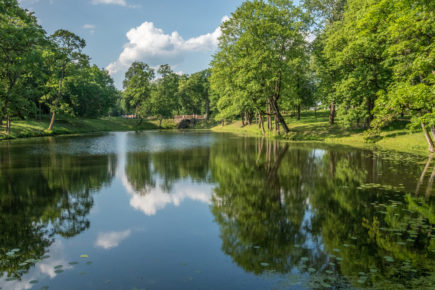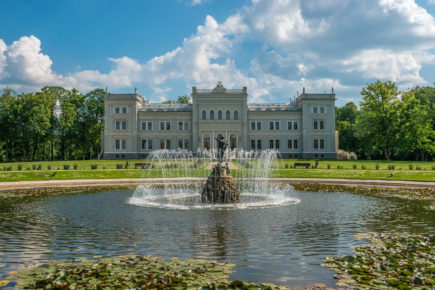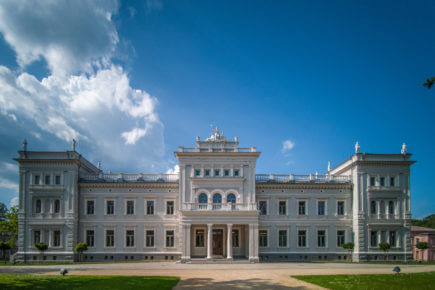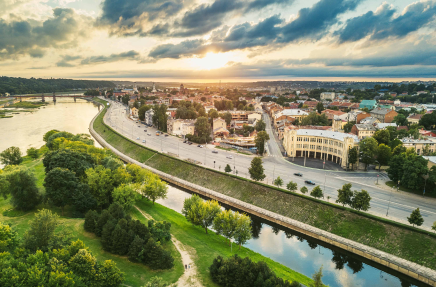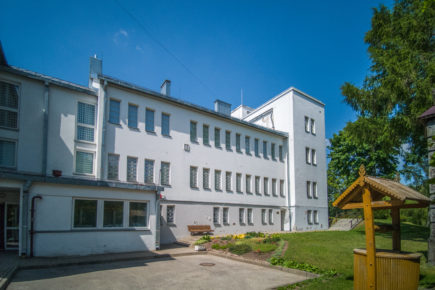This Plungė Manor complex of buildings from the second half of the 19th century is famous for its Duke, Mykolas Oginskis, and is one of the best-preserved in Lithuania. The manor house, called the Versailles of Samogitia, is surrounded by a park that reveals the beauty of the Lithuanian landscape. This mansion is rich in history. One of the most important traces of history is the artist Mikalojus Konstantinas Čiurlionis, who studied at the music school that once operated in the manor.
Duke Mykolas Oginskis acquired the Plungė Manor from Count Zubovai in 1873. Six years later, Plungė was adorned with a “Neo-Renaissance swan” featuring a foundation letter written in three languages – Latin, Lithuanian and Polish. In this way, the Duke symbolically financed Western civilisation and the Lithuanian state in Plungė within Tsarist Lithuania.
The centre of the manor became a Neo-Renaissance style palace designed by German architect Karl Lorenz. The palace was solemnly consecrated in 1879.
Mykolas Kleopas Oginskis (1765–1833), the creator and nurturer of Plungė Manor, was married twice. His first wife was Isabelė Lasocka and his second was Maria de Neri. He had two sons with his first wife, as well as three daughters and one son with his second wife. M. K. Oginskis divorced Izabelė Lasocka in 1802 and married the widow of Samogitian nobleman Kajetonas Nagurskis; the singer Maria de Neri from Venice.
In 1815, M. K. Oginskis lost hope in the possibility that the Lithuanian State could be restored at the Congress of Nations. As such, he left his estates to his wife and children around 1822 and went to live in Italy, where he died.
It is no coincidence that Mykolas Oginskis preserved the traditions of the Samogitian people, who are a symbol of fierce struggles for freedom against the crusaders. When they first entered the territory of Lithuania together with the Baltic tribes some 5,000 years ago, the Samogitians became a symbol of victory and strength. In the 19th century, the Samogitian people found themselves on the verge of extinction. After all, along with the conquest of the state, the need of the Lithuanian army, and hence the fighting horses, disappeared. Duke Mykolas Oginskis, who restored the Samogitian stud farm and thus preserved the breed, also preserved a reminder of the victorious times of the Lithuanian state in this way.
Plungė Manor is an impressive-looking two-storey brick building with four corner-raised avant-corps. The façades of the avant-corps are decorated with sculptures, which is a rare phenomenon among Lithuanian manors. Today, there are nine buildings that make up the Plungė Manor homestead: the left and right officinas, the stud farm, the lawyers’ and caretakers’ house, the laundry area, the park gate, the guard house, and the clock conservatory. The officinas once housed a manor office and a school. Horses and carriages used to be kept in the stable, which was also inhabited by servants caring for the horses. A horse-riding arena was installed in the middle part of the building.
The exterior aesthetic of Plungė Manor is pleasing, but the interior of the manor is even more surprising. The interior, like the exterior, is full of ornate details. Various mouldings, collectible furniture, impressive stoves, chic details and gilded picture frames are just some of the interior details that help visitors imagine how one of the most famous families of the 19th century once lived. Not all landlords formed orchestras in their manors; however, music was an essential part of the aristocratic worldview and any educated individual. The most prominent and wealthiest created and maintained their own manor orchestras – symphonic or chamber orchestras, depending on the landlord’s needs and finances. After all, the new romantic music of the 19th century required an entire symphony orchestra. After marrying Maria Skuževska, a former freilin of the Austrian emperor, Mykolas Oginskis also attracted elements of the Habsburg manor to his own. He and his wife travelled throughout Western Europe and listened to concerts by the most famous musicians of the time. This influenced the Plungė Manor orchestra and a musical culture radiated from the entire manor. The Plungė Manor orchestras performed works by the most famous contemporary composers (for example, Richard Wagner) and all the music written until then, including the famous Viennese classics like Haydn and Mozart.
The pseudo-Renaissance Oginskiai Park gate is where Duke Mykolas Oginskis and his wife Maria entered the manor on horse-drawn carriages. Mykolas Oginskis also reflected Samogitian identity and Lithuanian strength in the representative manor gates: they depict the Samogitian symbol of a bear and 16th-century Lithuanian soldiers, who gloriously defeated the much larger Russian Tsarist forces.
Today, the Plungė Tourism Information Centre is located at this gate. There is a small guardhouse next to the gate. During the Oginskiai era the on-duty guard opened and closed the gates and guarded the park.
According to legend, the Plungė Manor Park was established in the 18th century to create an ancient alcove in the place of a pagan sanctuary, as if extending the ancient identity of Samogitia to the aristocratic times of Lithuania. A Perkūnas oak tree thought to be one of the oldest and largest in the country stands in the park. The central part of the park occupies a high, smooth terrace, which has a geometric plan. The other part is occupied by a landscape park, which includes the Babrungas riverbed and springs. The west part has four ponds and the east has three. The main alley starts at the gate on the south-eastern edge and ends at the palace. Next to the palace is a spacious terrace with views of the park and the river. A round pool was dug in front of the palace; it features an island with a statue of Venus with cupid.
In the manor park we can see a building older than the palace itself – the clock tower conservatory, the date of which is preserved in the masonry foundation stone – 1846. It is the oldest building in Plungė. This is a miniature copy of Palazzo Vecchio in Florence. The clock built into the tower has only one arrow and a bell.
The 12-metre high clock tower is of the Romanticism Neo-Gothic style, and the clock is visible from all sides. This clock tower is also called the Lithuanian Taj Mahal, because the head of Plungė Manor, Nikolajus Zubovas, built it to commemorate his wife Aleksandra after her death. Today, the clock tower houses a library where people can relax and get inspired.



